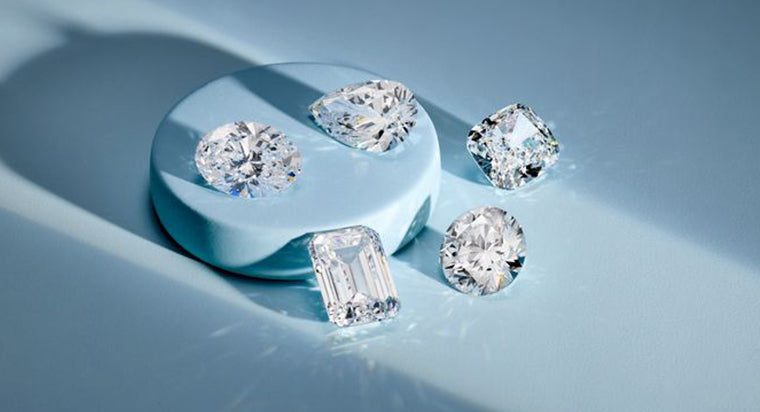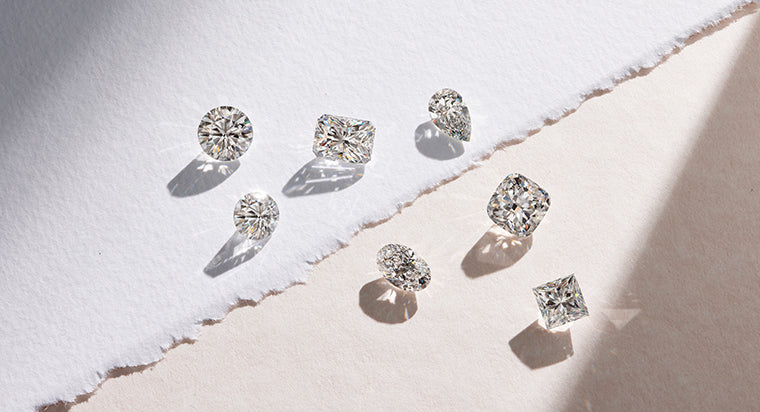Diamond Certification: Guide to GIA Diamond Grading
TABLE OF CONTENTS
How Are Diamonds Graded
Diamond grading is a very elaborate process. Anonymity is extremely important to them, not just at the beginning, but throughout the entire diamond grading duration. Once a diamond arrives at their laboratory, each diamond is put into a custom designed and transparent storage case. If the diamond came with any references of who its owner is, this is immediately removed and/or concealed. The diamond is then given a barcode with a unique ID number which will track it during the grading process.
Diamond Grades
Diamonds are beautiful, meaningful, and forever. Shopping for the precious gems, however, can be overwhelming. Not only do you have to choose the right cut, style, and color for the person for whom you are shopping, you must decide which diamond is the best value. Luckily, along with years of experience with diamond jewelry, and helping customers just like you pick the perfect gem, jewelers also have the diamond grading scale at their disposal to alleviate some of the diamond shopping pain. Diamonds are graded by labs around the world that each have their own methodology and their own grading scale. With Clarity carries GIA graded diamonds, as well as IGI certified Lab diamonds. This ensures that diamonds are graded on a stringent scale. This ensures all diamonds are graded on the same scale and are easy to compare with one another.

Why Are Diamonds Assigned Grades?
Diamonds have been mined for centuries. However, without grades, the quality and value of these diamonds is subjective. Graded were determined by jewelers and independent laboratories to ensure that diamonds are being judged on the same scale. This help both the buyer and the jeweler to understand what the value of the diamond should be.
Diamond Grading Factors
The diamond cut grade is based on symmetry, cutlet size, facet positioning, polish and shine, and other prominent external properties of the diamond. Jewelers would spend a considerable amount of time examining diamonds if each property had to be graded individually. However, the diamond cut grade is established by combining all these properties and evaluating them as one single, simplified category. Experts believe that this grade should be the customer's chief concern when shopping for diamonds. A well-cut, slightly blemished, or tinted diamond looks far better than a clear, terribly-cut stone.

What is the GIA Diamond Grade Scale?
The GIA scale measures the color grade of diamonds, size, position, and nature of the diamond, as well as the other three C's of diamond grading: carat, clarity, and diamond “cut” grade. There are 11 different grades in the GIA diamond grading scale. The diamond grades include the flawless (FL) classification, and extend to inclusion levels down to “included,” which means that the blemishes in the diamond stand out in the 10X magnification test. Depending on the “included” grade level the diamond receives, the imperfections may have an impact on the shine and opaqueness of the stone.
How was the Grade Scale Established?
Jewelry speaks its own language, which is understood worldwide. However, jewelers and appraisers all had different terms for diamond qualities, and misunderstandings created problems in the diamond market. If “pique” meant two different things to two individuals, people might get the wrong impression of what they were buying, and disappointed customers make for bad business. Now, with the grading scale in place, most jewelers know the simplified terms such as “SI2,” and “VVS1,” that make the diamond grading system so easy to understand.
Why is it Important to Buy a Graded Diamond?
While it is not necessary to buy jewelry according to a diamond grading chart, it certainly saves a great deal of stress when diamond shopping. Grades allow you to easily determine is a jeweler is overcharging you or providing you with fair prices. Grades also give you the ability to compare the prices and selection that jewelers offer against each other. Finally, grades and certificates ensure that the diamond will have resale value if you ever decide that you want to pass it forward or sell or upgrade it. Certificates also help when getting jewelry and diamonds appraised and insured.
The most important time to choose the right diamond is when you are buying an engagement ring. People often assume that the shinier a diamond appears, or the larger the carat, the better quality the diamond is. However, according to the diamond scale, a poorer graded diamond can be more visually appealing, if cut and sized properly, than a larger, more blemished stone.
Learning the diamond grading scale, and what each grade and subgrade means, can keep you from making a hasty purchase you later regret. Since the diamond grading system evaluates many diamond qualities combined to grade the diamonds, there is no need for confusing carat comparisons or misleading appearance checks. Simply research the different diamond grades, discuss them with your jeweler, and choose! The higher you go on the grade scale for cut, color and clarity, the cost of the ring can get incrementally higher. So narrow down which factors of the diamond are more important to you. Start with the part of the ring that is the most important to you. If she is particular about the setting, be sure you've narrowed that down first.
This is especially handy when selecting an engagement ring. It makes the process faster, and you can be more confident that she will fall in love with the ring, just the way she fell in love with you. Use everything you have learned about diamond grades and the diamond grading chart to purchase your jewelry wisely. Rely on the diamond grading scale and a trustworthy jeweler to help you choose. These qualities have already been examined and rated for you, and your jeweler is there to help you compare overall grades, not nitpick individual qualities until everything is a blur. And remember; size does matter, but only a little! The larger the diamond, the more obvious any blemishes will be, and the more perfect the stone must be to avoid appearing flawed or cloudy. Smaller stones will conceal more flaws, and emphasize the stone's cut, which contributes a great deal to the diamond's overall appearance. Be confident and happy with your purchase and be sure to work with a jeweler that has a good return and warranty policy.
Grading Diamond Carat
The equipment used to measure the weight of the diamond is an electronic micro-balance. This captures their weight to the fifth decimal place. Another tool used during this process is an optical measuring device. This device dictates their exact measurements, proportions, and all facet angles. One of the most important tools used during the diamond grading process is the GIA Diamond Check. Every item that is submitted to the GIA for diamond grading is examined with this before anything else is done to the diamond. This instrument determines whether the diamond is natural, synthetic, or whether it requires further testing for treatments. There isn't one diamond graded that isn't first examined with this tool. The value of this instrument is $23,900.00.
Grading Diamond Color
Color is often one of the first things that a diamond is graded for. The light source and the background can have a major impact on how the color appears. Therefore, the GIA grades diamonds in a standardized viewing environment. There are multiple color graders who each submit their independent opinions into the system without consulting with each other. None of them know what color grading choice the other has chosen. Once everyone is done, the color grade is determined by inspecting what color was chosen by the majority of the color graders.
Grading Diamond Clarity
Clarity of diamonds is graded with 10x magnification under standard viewing conditions. Professional diamond graders will carefully examine the diamond in order to locate specific clarity and finish characteristics. They also look for any evidence of previous diamond treatments, such as laser drilling or feature filling. The grader will then assign their professional opinion on the diamond's overall clarity, polish, and symmetry. They plot these characteristics onto a diagram that represents the diamonds shape and faceting style. During this time, the grader will verify the previously captured weight and measurement data. They will then write a thorough description of the diamond's culet, along with its girdle thickness. This process isn't done by just one grader - many more experienced gemologists that work at the GIA will then review all of the previous grading information before finalization. Grading results are only finalized once all the opinions are agreed upon.
Grading Diamond Cut
This cut quality grade is only for standard round brilliant diamonds. The diamonds must fall into the GIA D-Z color range. Once the color and clarity grading process is complete, the diamond's proportions and descriptions from the above steps are used to determine its GIA Cut Grade. Graders also take into consideration the brightness, weight ratio, durability, symmetry, and scintillation (sparkle and pattern) when assessing the final cut quality.
Diamond Grading Process
During every single step of the diamond grading process, there is special care, handling and inspection procedures put into place to ensure the diamond's identity stays protected. The diamonds are always managed with utmost care and their anonymity is carried until the very end. Did you know that every single diamond in the GIA is tracked electronically? This means that the laboratory can pinpoint the exact location of any diamond at absolutely any time. This is great because it's also very easy to review each step during the diamond grading process. The highest and most up to date technology is used for this step. Highly trained and alert staff are constantly monitoring and keeping track of all inventory.
Once the entire diamond grading process is finished, the GIA will issue the diamond a certification. This is a very thorough and professional report. It includes micro-print lines, a hologram, and multiple other security components before it finally gets laminated. This process ensures that the certificate will be preserved for a long period of time. After that, GIA staff will ensure that the diamond certification is then safely delivered to the owner, along with the diamond that was being graded. It's an intense and thorough process, and every diamond that gets graded by the GIA is treated with the utmost care.
FAQs
What is GIA & AGS?
Why is Diamond Grading Important?
What Are the “Four C’s”?
What does the unique certificate number indicate?









